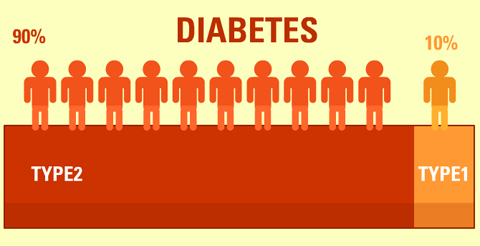Diabetes mellitus, often simply diabetes is a syndrome characterized by disordered metabolism and inappropriately high blood sugar (hyper- glycemia) resulting from either low levels of the hormone insulin, or from abnormal resistance to insulin’s effects coupled with inadequate levels of insulin secretion to compensate. The characteristic symptoms are excessive urine production polyuria, excessive thirst and increased fluid intake polydipsia and blurred vision; these symptoms may be absent if the blood sugar is mildly elevated.
Diabetes Type I
Type 1 diabetes mellitus is characterized by loss of the insulin-producing beta cells of the islets of Langerhans in the pancreas, leading to a deficiency of insulin. The main cause of this beta cell loss is a T-cell mediated autoimmune attack. There is no known preventative measure that can be taken against type 1 diabetes, which comprises up to 10% of diabetes mellitus cases in North America and Europe (though this varies by geographical location). Most affected people are otherwise healthy and of a healthy weight when onset occurs. Sensitivity and responsiveness to insulin are usually normal, especially in the early stages. Type 1 diabetes can affect children or adults but was traditionally termed “juvenile diabetes” because it represents a majority of cases of diabetes affecting children.
Diabetes Type II
Type 2 diabetes mellitus is due to insulin resistance or reduced insulin sensitivity, combined with reduced insulin secretion. The defective responsiveness of body tissues to insulin almost certainly involves the insulin receptor in cell membranes. In the early stage the predominant abnormality is reduced insulin sensitivity, characterized by elevated levels of insulin in the blood. At this stage hyperglycemia can be reversed by a variety of measures and medications that improve insulin sensitivity or reduce glucose production by the liver. As the disease progresses the impairment of insulin secretion worsens, and therapeutic replacement of insulin often becomes necessary.
There are numerous theories as to the exact cause and mechanism in type 2 diabetes. Central obesity (fat concentrated around the waist in relation to abdominal organs, but not subcutaneous fat) is known to predispose individuals for insulin resistance. Abdominal fat is especially active hormonally, secreting a group of hormones called adipokines that may possibly impair glucose tolerance. Obesity is found in approximately 55% of patients diagnosed with type 2 diabetes. Other factors include ageing (about 20% of elderly patients in North America have diabetes) and family history (type 2 is much more common in those with close relatives who have had it). In the last decade, type 2 diabetes has increasingly begun to affect children and adolescents, likely in connection with the increased prevalence of childhood obesity seen in recent decades in some places.
Type 2 diabetes may go unnoticed for years because visible symptoms are typically mild, non- existent or sporadic, and usually there are no ketoacidotic episodes. However, severe long-term complications can result from unnoticed type 2 diabetes, including renal failure due to diabetic nephropathy, vascular disease (including coronary artery disease), vision damage due to diabetic retinopathy, loss of sensation or pain due to diabetes neuropathy, and liver damage from non- alcoholic steatohepatitis.
Unfortunately, you can’t get rid of Diabetes. But you can prevent it, and you can control it. It is important that we follow a balanced diet. We should eat 5-6 small meals per day, consisting of fibre, fruit, vegetables, meat and dairy. Never eat or drink too much of one thing. Limit sugar intake eg. sodas, chocolate, sweets and sugar filled breakfast cereals. Opt for healthier options. It is best to eliminate processed foods from your diet completely. Consuming processed products not only leads to diabetes, but can lead to a long list of other diseases. Stay active by taking a walk in your neighbourhood in the evenings or stop as far away from a shopping centre’s entrance.
Ozone Therapy can help you get your Diabetes under control as it improves blood circulation, breaks down excess sugar, neutralise toxins and impurities, assists bodily organs to function better and breaks down cholesterol. Ozone Therapy can also help you loose weight. You can loose up to 500 calories in each 30 minute session. For more on the benefits of Ozone Therapy, click here.
Please feel free to contact us for more information regarding Ozone Therapy and Ozone Steam Saunas:
Salvagente
+27 (0)72 422 1967
[email protected]
Fill in the form below to receive a summary of our weekly blogs in your inbox.
[contact-form][contact-field label=’Name’ type=’name’ required=’1’/][contact-field label=’Email’ type=’email’ required=’1’/][/contact-form]








Leave a Reply